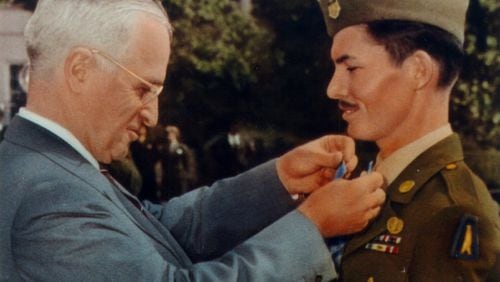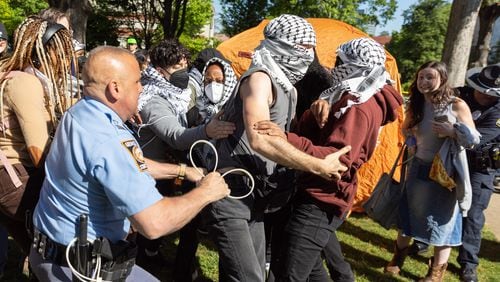Desmond T. Doss, the pious and diminutive North Georgian — and one of the most badass pacifists ever — is now the focus of a very violent, and equally uplifting movie.
If the recent presidential election has left you questioning the sense of decency and commonality in the American spirit, then check out this film about one man’s steadfast and unwavering devotion to his core principles. But, like I said, if you’re the squeamish sort, it might not be for you. It is the ultimate rendition of war as hell, flying body parts and all.
In recent weeks, trailers for "Hacksaw Ridge" have aired and at first glance, the plot line looks like standard fare as Hollywood flicks go — lots of explosions and a boy-meets-girl and goes off to war subplot.
But I dragged my wife along to the theater Monday night out of curiosity because I once interviewed Doss and then, a decade ago, wrote his obituary for The Atlanta Journal-Constitution.
I was wondering how Hollywood would treat this most remarkable American hero, a self-described “misfit,” a reluctant warrior but a fellow who was gung-ho when it came to serving his country.
Doss, a country boy and devout Seventh-day Adventist, enlisted not long after Pearl Harbor. But he quickly ran headlong into the unyielding bureaucracy of the U.S. Army, because he refused to pick up a rifle. His aversion to weapons became a problem because Doss was assigned to a rifle company. Yet, the unyielding Army eventually budged in the face of the incredibly resolute Doss and let him serve as a medic.
His heroics are well known, even now iconic.
He became the first conscientious objector to receive the Medal of Honor, with numerous examples of bravery in battles with the Japanese. He is credited with saving more than 75 lives over the course of three weeks during the ferocious battle of Okinawa, where Americans and Japanese were locked in a hellish landscape of untold brutality.
Doss is most famous for single-handedly lowering by rope dozens of wounded soldiers down the face of a cliff, one-by-one, while under intense fire. The movie makes it look like the feats he accomplished are wholly unbelievable. But it’s one of those occasions when fiction can’t touch the truth.
Doss was wounded and in and out of hospitals for years after the war. He undoubtedly suffered PTSD and was unable to sustain a full-time career. In the 1950s, he settled in Rising Fawn in the mountains of northwest Georgia, living with his wife, Dorothy, and eking out a living with small-time farming and being a handyman.
His hearing loss and accompanying lack of tone control while speaking made him difficult to understand. But the proud, yet humble 130-pound hero would routinely throw on his uniform (it forever fit) and tell his story in a detached manner. He spoke as if he were merely an instrument of God, crawling across battlefields and dragging horribly disfigured comrades to safety.
He spoke to veterans’ groups, churches, reporters and especially to children.
John Swafford, a retired Seventh-day Adventist minister from Calhoun said Doss, who had a son, was intensely interested in the Pathfinders, which is sort of the Adventists’ scouts.
“He came to all our jamborees and told his story,” Swafford said.
In the movie, Doss is almost frenzied in his focus to “get one more, one more” man lowered down the cliff.
Similarly, Swafford said, “he wanted one more young person to encourage, always one more.”
Turning Hollywood away, time and again
And happy as he was to give his story away to people face to face, he wasn’t so keen on selling it.
For decades, Hollywood producers came to him and for decades they left without a deal.
Swafford recalls Doss often telling him, “They keep wanting to make a movie about me but I don’t want them to make the wrong story.”
Doss, he said, “was concerned the story would be glamorized and worried what Hollywood would do with it.”
In the late 1990s, Doss got together a handful of friends and associates and founded the Desmond Doss Council, which is associated with the Georgia-Cumberland Conference of Seventh-day Adventists. In essence, the council became the guardian of Doss’ story.
Dr. Charles Knapp, a retired Army colonel and an Adventist, is the chairman of the Doss Council and was the org’s point man as the movie got made. Over a 29-year-Army career, Knapp served in Vietnam and during Desert Storm and, among other duties, oversaw medical units staffed with latter-day Dosses.
A movie deal was struck more than a decade ago, when Doss was still living.
Ultimately Mel Gibson was chosen as director, a man who has delivered both brutal war sagas and religious passion plays. As it turns out, some of the standing ovations and positive press surrounding his latest movie are helping to resurrect (to employ a religious term) Gibson’s reputation in Hollywood.
'We hope this causes people to think'
Knapp, a North Carolina resident who was in Atlanta this week, read the scripts, visited sets and was involved in movie focus groups. He did not have to do much wrangling with the script, although he notes “it’s probably the only war film without any F-bombs or taking of the Lord’s name in vain.”
The movie is “beyond religion, it’s about the spiritual core of individuals,” he said. “Desmond was a man of incredible simple integrity, the integrity of doing the right thing when no one is looking.
“We hope this causes people to think and enter discussions of those attributes that our society seems to be losing — integrity and compassion for one another.”
I asked Swafford, who gave the eulogy for Doss in 2006, what he hopes sticks with movie-goers.
“We all see so many things skewed in life,” he said, “and we appreciate when someone stands up and lives up to what they believe.”
So simple, yet so hard.
About the Author







